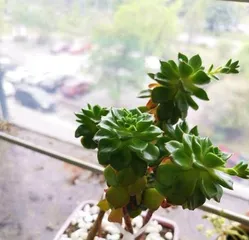Succulent plants are beloved by enthusiasts for their unique shapes and ease of propagation. Among them, Sedum Diya is particularly notable, serving as both an indoor decoration and an outdoor plant for balconies and gardens. So, is Sedum Diya easy to care for? This article will provide a detailed introduction to its cultivation methods and key care points.

I. Understanding the Basic Characteristics of Sedum Diya
Sedum Diya, a plant of the Crassulaceae family, mainly grows in tropical and subtropical regions. It has a short trunk, dense side branches, and thick, fleshy leaves. Its most prominent features are its vibrant colors and unique shapes.
II. Choosing a Suitable Growing Environment for Sedum Diya
Sedum Diya thrives in environments with plenty of sunlight, moderate temperatures, and good air circulation. When planting, choose a location that is well-lit, has good airflow, and has moderate humidity, preferably within a temperature range that is conducive to its growth.

III. Soil Requirements for Sedum Diya
Sedum Diya prefers loose, well-draining soil rich in organic matter. You can create the soil using loose materials such as perlite, vermiculite, and sand.
IV. Propagation Methods for Sedum Diya
The main propagation methods for Sedum Diya include sowing, cuttings, and division. Cuttings and division are more common. For cuttings, select healthy stems and leaves, let them dry after cutting, then insert them into the soil. They will take root and sprout after a certain period.
V. Watering Methods for Sedum Diya
Sedum Diya should not be overwatered, as this can easily lead to rotting and other problems. Generally, watering once a week is sufficient. When watering, thoroughly moisten the soil to maintain a certain level of humidity.

VI. Fertilizing Methods for Sedum Diya
Sedum Diya does not have a high demand for fertilizer. You can mainly use organic or compound fertilizer, applying it once every 2-3 weeks. However, be careful not to over-fertilize to avoid salt buildup.
VII. Paying Attention to the Care of Sedum Diya
During the care process, it is important to prune in a timely manner, remove pests, and prevent diseases to ensure the healthy growth of Sedum Diya. Additionally, when performing operations like repotting or pruning, be careful not to damage its leaves and roots.
VIII. Adjusting the Environment for Sedum Diya as Needed
When Sedum Diya experiences changes in temperature or insufficient sunlight, adjustments are necessary. At this time, you can repot it or adjust the light to ensure its normal growth.
IX. Protection of Sedum Diya
Sedum Diya is often attacked by pests such as spider mites and whiteflies. During care, it is important to spray pesticides in a timely manner to prevent pest infestations.
X. Regularly Cleaning the Leaves of Sedum Diya
The leaves of Sedum Diya often accumulate a lot of dust, which affects its respiration and photosynthesis. It is recommended to clean the leaves regularly to keep them clean and fresh.
XI. Being Observant of the Growth State of Sedum Diya
Only by being observant of the growth state of Sedum Diya can you take appropriate measures at the right time to protect its healthy growth.
XII. Repotting Sedum Diya
Sedum Diya needs to be repotted once a year to ensure its normal growth. When repotting, pay attention to choosing new soil suitable for its growth and appropriately trimming its roots.
XIII. The Dormancy Period of Sedum Diya
Sedum Diya enters a dormant period during the cold season. At this time, the frequency of watering and fertilizing should be reduced, and the soil should be kept slightly moist.
XIV. Meticulous Care for Sedum Diya
Only with meticulous care can Sedum Diya grow healthily. This requires patient observation, regular cleaning, and timely adjustments.
XV.
Sedum Diya is a succulent plant very suitable for both indoor and outdoor growth, with rich colors and shapes that make it a favorite among enthusiasts. In the cultivation process, it is necessary to pay attention to selecting suitable growing conditions such as environment and soil, as well as regular pruning, fertilizing, and pesticide spraying, and timely adjustment of its growing environment. Only in this way can Sedum Diya grow healthily and become one of the most eye-catching plants in your home or garden.